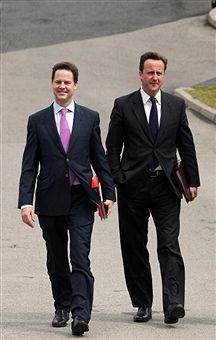 The coverage in today’s FT is a reminder that one question will pursue the coalition more doggedly than any other: are the cuts fair and
“progressive”? This isn’t an issue that Osborne & Co should duck, and not just because they’ve set it as a measure of their own success. There is, to my mind, a moral and economic
necessity for measures that benefit the least well-off – and, what’s more, this is terrain which the coalition should feel quite comfortable traversing. Benefit reform, schools reform,
lifting low-income earners out of tax: these policies provide a solid foundation for an argument about fairness.
The coverage in today’s FT is a reminder that one question will pursue the coalition more doggedly than any other: are the cuts fair and
“progressive”? This isn’t an issue that Osborne & Co should duck, and not just because they’ve set it as a measure of their own success. There is, to my mind, a moral and economic
necessity for measures that benefit the least well-off – and, what’s more, this is terrain which the coalition should feel quite comfortable traversing. Benefit reform, schools reform,
lifting low-income earners out of tax: these policies provide a solid foundation for an argument about fairness.
If the coalition wants to develop that argument persuasively, then it should remember four points:
1) The graphs don’t show the whole picture. Many of the graphs which have been used to “prove” that the Budget was unfair operate only on a tax-and-spend basis. The VAT hike gets fed into the equation, for instance, as do reductions in benefits – so that winners and losers are determined by how much money they’ve lost and gained overall. This is a useful measure, but it is not the only one. As yet, the graphs don’t account for policies which operate on a less straightforward basis – such as IDS’s benefit reforms, or Gove’s schools reform plans. These should have a positive impact for the least well-off, but the proof will come in years’ time. Not in a graph stapled onto the last Budget.
2) Playing to the graphs can be counterproductive. In the aftermath of the Budget, there was a sense that the coalition had tweaked some policies to make the graphs read more “progressive”. And so child tax credits were increased at the lower end of the income distribution, and cut at the upper. This is all well and good, you might think. But, as the IFS pointed out at the time, the overall effect of these kinds of changes was to place more disincentives in the way of people climbing up the income ladder. For those who regard the current benefits system as the barrier to opportunity it is, simply pushing money downwards is not the solution.
3) Soaking the rich can be counterproductive. Similar to the second point above, the coalition should be careful about targeting the rich for presentational purposes only. The 50p tax rate is the classic example on this front. If it loses money, as the IFS suggests it might, then the shortfall will need to be made up elsewhere – perhaps via spending cuts or tax rises for the less well-off. What comes dressed up as “progressive” can sometimes be anything but.
4) Labour would have faced the same problems. The main point of the FT article today is that spending cuts will hit the poorest hardest, because they rely more on public services. It’s reminiscent of the point that women would bear the brunt of the Budget cuts because they’re disproportionately represented in the public sector. Neither of these facts should be ignored by the government. But nor would it be fair to suggest that this is somehow a failure unique to the coalition. Labour had spending cuts of 20 percent pencilled in for the next few years – and they too would have had an impact on women and the least well-off. Cuts mean losers. The point is to work out how those losses can be minimised, or even overturned, during an era of spending restraint.






Comments